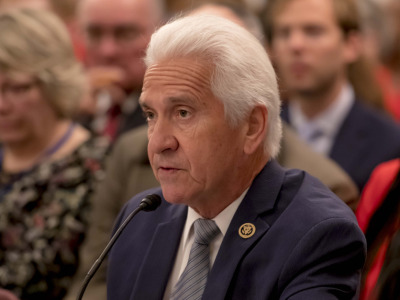Along with providing food to struggling low-income families, USDA’s Supplemental Nutrition Assistance Program has increasingly focused on developing new ways to help SNAP beneficiaries graduate from SNAP by finding stable jobs.
As the largest U.S. anti-hunger program, SNAP – previously known as food stamps – provided $63.6 billion in benefits to 42 million people in fiscal year 2017.
The House-Senate conference on a new farm bill scrapped the House proposals to expand SNAP work requirements while continuing traditional SNAP E&T (Employment and Training) programs that currently cost USDA about $300 million per year.
The final farm bill instead includes the Senate proposal to support a new “outcomes-based” approach developed in 10 E&T pilot programs funded with a one-time expenditure of $200 million in competitive grants provided by the 2014 farm bill. The pilots target the toughest cases – the SNAP recipients facing major barriers to employment such as long-term unemployment, homelessness, a prison record, or drug addiction.
A Republican summary of the nutrition title cites California’s Fresno Bridge Academy and Washington state’s Resources to Initiate Successful Employment (RISE) as two pilots that have been especially successful, and the bill includes a provision to redirect not less than 50 percent of unspent E&T funds toward such projects. (Dropped from the final bill was a Senate-passed provision that would have created more pilot projects.)
In the California case, Fresno Bridge Academy (FBA), now operating across five counties as California Bridge Academies, began as a private effort in 2010 after Fresno County turned down retired businessman Peter Weber when he first proposed his outcomes-based approach for moving SNAP beneficiaries into stable jobs. So, Weber launched the program on his own because, as he says, “Education and training are indispensable but insufficient.”
FBA’s first years of providing Weber’s “whatever’s-needed” approach to helping SNAP beneficiaries find and keep jobs was so successful that in 2012 the county got federal SNAP E&T funding to expand FBA’s work with SNAP beneficiaries (known as CalFresh beneficiaries in California).
After FBA’s years of success, this year Fresno County surprisingly planned to end its contract with FBA to service SNAP participants. So a host of voices, including that of Rep. Jim Costa, D-Calif., stepped in to help reverse the county’s position.
Costa also encouraged the farm bill negotiators to focus more SNAP E&T funding on the new pilot programs. Insisting hunger "is a real crisis in the San Joaquin Valley,” Costa told fellow conferees that “removing people from SNAP to pay for an unproven workforce training program – as is in the House bill – is the wrong thing to do.” Instead, he called for supporting the 10 pilot projects to “help us find solutions and pathways to work, as shown in California’s pilot project at the Fresno Bridge Academy.”
After taking that message to both Fresno county supervisors and farm bill negotiators, Costa tells Agri-Pulse “the Fresno pilot has achieved real success.

California Rep. Jim Costa speaks at the Farm Bill Conference Committee meeting. (Photo: Joy Philippi)
"More than 80 percent of Fresno Bridge Academy’s participants are placed in stable employment," he said. "And of that group, 83 percent were still employed by the same company one year after placement. Participants are becoming employed and remaining employed, putting them on the path to real self-reliance.”
Costa also noted 30 percent of FBA participants achieve full self-reliance prior to graduating from the 18-month program.
"It is more than just job training," he said. "It’s mentoring, it’s guidance, and it’s achieving real results."
Along with this initial outcomes data, Costa says it’s also important to “monitor participants in the pilots over the long term to see what practices have led to lasting success and self-reliance. It’s one thing to see if a program gets someone off of assistance and into a job, it’s another thing altogether to see if that person is able to grow and maintain their successes for one, two, three years and hopefully for a lifetime.”
Program costs have proven to be a key difference between the Bridge Academy and traditional E&T programs. Operating traditional SNAP E&T programs costs USDA around $300 million per year. The FBA approach shows a net return of “$5.50 per taxpayer dollar invested.”

Kristina Rasmussen, Foundation for Government Accountability
Kristina Rasmussen, vice president of federal affairs with the Foundation for Government Accountability, isn’t convinced. She tells Agri-Pulse while the pilots may be “worth studying more closely,” they are tiny “compared to today’s seven million open jobs in the private sector.”
Rasmussen says the farm bill negotiators missed a major opportunity when they rejected House farm bill proposals to:
- Add work requirements for recipients without young children to SNAP’s current work requirements for able-bodied recipients without dependent children.
- Limit the ability of states to obtain waivers from work requirements “so that states couldn’t continue to gerrymander areas to exempt more people or manipulate data to exempt more people or exempt people in areas with low unemployment.”
Rasmussen says these rejected House proposals offered “a great opportunity to help move more able-bodied folks from dependency into the work force.” She says that since the farm bill failed to make the needed changes, the Trump administration is ready to implement new rules in 2019 to tighten SNAP requirements “so that the regulations more closely align with the intent of Congress to get able-bodied adults working.”
Agriculture Secretary Sonny Perdue is expected to issue a proposed rule soon that will make it more difficult for states to get waivers from the existing work requirements for able-bodied adults without dependents (ABAWDs). A provision the rule is expected to tighten currently allows states and counties to qualify for a waiver if their unemployment rate is just 20 percent above the national rate for a 24-month period.
Rasmussen expects many more SNAP beneficiaries to find work in today’s booming economy once the administration tightens SNAP eligibility rules. She says many employers now are “being very generous in saying, 'Show up with a smile, pass a drug test, and we will train you because we’re so desperate for workers.’”
One problem with Rasmussen’s argument is USDA’s conclusion that the traditional SNAP E&T approach hasn’t worked. USDA’s 106-page SNAP E&T Best Practices Study concluded in 2016 that “serving large numbers of mandatory participants with relatively inexpensive services like job search and job search training . . . did not lead to increased employment and earnings for SNAP E&T participants over time.”
For more news, go to www.Agri-Pulse.com


